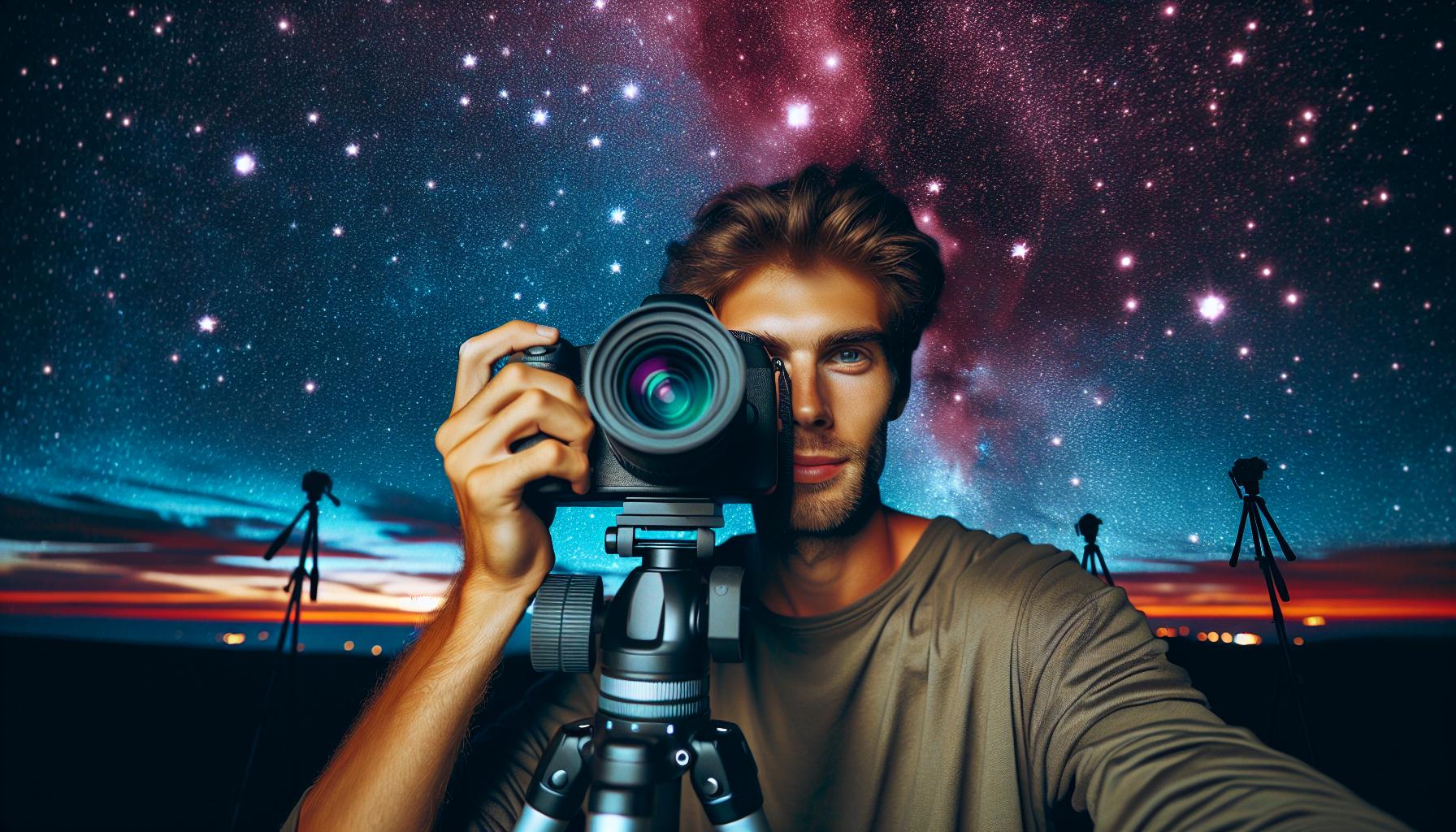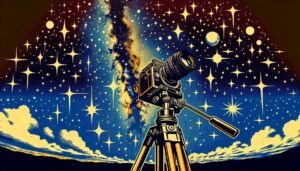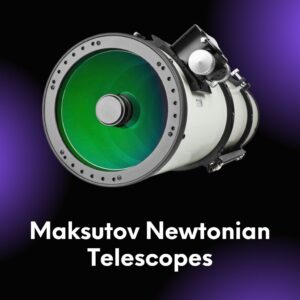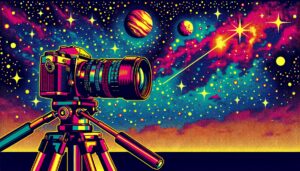This site contains affiliate links to products. I may receive a commission for purchases made through these links.
Stepping into the world of astrophotography can seem daunting at first. But don’t worry, I’m here to guide you through it. The first thing you’ll need is the right camera. It’s not about the most expensive one, but the one that suits your needs and skill level.
Astrophotography is a unique niche that requires specific features from a camera. From long exposure capabilities to high ISO ranges, there’s a lot to consider. Don’t be overwhelmed, though. I’ll help you understand what to look for.
Remember, everyone starts somewhere. With the right beginner astrophotography camera, you’ll be capturing the night sky in no time. And remember, it’s your passion and patience that will take your astrophotography to the next level, not just the camera. Let’s get started on this exciting journey.
What is Astrophotography?
Astrophotography, it’s a specialized type of photography that focuses on capturing the beauty of our cosmos. It’s a field where science and art collide, where photographers ponder over the mysteries of the universe, capturing the dazzling celestial objects in space with their lenses.
It differs from traditional photography not merely in its subject but also in the techniques required to seize the perfect shot. For instance, where normal photography relies on the available light from the sun or artificial sources, astrophotographers draw light directly from the stars. This requires unique camera features capable of long exposures, and high ISO ranges; an area we’ll delve into later on.
Astro-imaging, as it’s often called, also comes in various forms. There are different types including telescopic astrophotography, wide-field astrophotography, time-lapse astrophotography, and even solar system astrophotography, each with its own unique fascination. Telescopic astrophotography brings distant galaxies into our view, while wide-field astrophotography captures meteor showers and constellations. Time-lapse photography lets us watch stars traverse the night sky, and solar system photography aims our lenses at the planets, asteroids, and comets within our own star system.
One can say astrophotography is not just a hobby or passion, it’s a journey into the unknown. A journey where every photo you take unravels some cosmic mystery, highlighting the sheer scale and beauty of our universe.
If you’re about to embark on this journey, I’m here to guide you through. Let’s help you choose the right camera for your needs and ensure that your passion for capturing the night sky, the planets, the galaxies, is not stifled by technological roadblocks.
Remember, even the most experienced astrophotographers were once beginners. With the right gear and a lot of patience, you’re on your way to capturing celestial wonders, taking your astrophotography to the next level.
Why do you need a beginner astrophotography camera?
A wise man once said, “The best camera is the one you have with you.” While this is true for general photography, the world of astrophotography is a different landscape altogether. The unique requirements of capturing the magnificence of celestial objects require specific camera features. So why exactly do you need a beginner astrophotography camera?
Firstly, it’s clear that astrophotography requires long exposure times. Your camera should be able to comfortably expose images for extended periods, often between 20 to 30 seconds, to gather enough light from distant celestial bodies. Standard point-and-shoot cameras may lack this capability or may struggle with overheating and battery issues during prolonged use.
Equally important is the camera’s ISO range. This feature determines how sensitive your camera sensor is to light. You need a broad ISO range to capture the delicate and often faint light from stars, galaxies and nebulae.
Some might suggest that you could use a standard DSLR camera for your astrophotography pursuit. However, it’s crucial to remember that many DSLRs have Low Pass filters installed that can actually blur the fine detail in astrophotography images. A specific astrophotography camera will feature either a removed or modified low pass filter allowing you to capture breathtaking cosmic details.
Additionally, a beginner astrophotography camera is, as the name indicates, designed for newcomers. These cameras have user-friendly interfaces and features. The ease of use and simplified settings offer a less daunting entrance for me to engage with astrophotography. Many of these cameras also offer tutorials and guides, making it even easier to jump in and start capturing the stars.
Moreover, embarking on your astrophotography journey with a beginner camera offers you the opportunity to learn and grow without a hefty investment. High-end astrophotography equipment can be incredibly costly and quite challenging to use. A beginner astrophotography camera offers a great balance between features, functionality, and cost-effectiveness, making it the ideal starting point.
Astrophotography as a hobby can be a wonderful and mesmerizing journey. With a beginner astrophotography camera, you’re well equipped to take the first steps towards capturing the celestial wonders that fascinate you. I hope you’re as excited as I am to get started.
Factors to consider when choosing a beginner astrophotography camera
Astrophotography is a world of its own, brimming with mind-boggling variables that make it distinct from traditional photography. That being said, there’s some critical elements you should think about when picking a beginner astrophotography camera.
Sensor Size and Type
Sensor size is integral because it determines the field of view and resolution of the image. Bigger sensors can capture more light – which is vital for astrophotography. Another key factor: the type of sensor. There’s two main types: CCD (Charge Coupled Device) and CMOS (Complementary Metal-Oxide-Semiconductor). While CCDs are known for their superior image quality and low noise, CMOS sensors are less pricey and have faster read times – but they might suffer from higher noise.
ISO Range
A large ISO range lets you capture images under diverse light conditions. A higher ISO setting can produce bright images even in low light, but beware – it could also add noise to the image. Still, having the capability to adjust ISO as needed can be convenient when photographing the cosmos.
Long Exposure Capability
Exposure is crucial when you’re shooting celestial objects. Look for a camera that allows for long exposure times. The longer your camera can expose, the more stars and other celestial bodies you’ll be able to capture.
Ease of Use and Budget
Astrophotography can be daunting at first. That’s why it’s important to choose a user-friendly camera that won’t overwhelm you with complicated settings and features. If you’re starting out, you probably don’t want to drop a fortune on a camera either. Hold off on the pricy models until you’ve honed your skills.
Sensor size and resolution
Moving on from our basic introduction, we’ll now delve into the specifics of sensor size and resolution. By understanding these intricate details, you’ll be better equipped to choose the perfect astrophotography camera for beginners.
Large sensor sizes are typically more advantageous for low light photography, like astrophotography. A larger sensor in your camera allows it to capture more light, which is fundamental for photography of stars, galaxies, and nebulae. An added perk is that larger sensors usually translate to a larger field of view, so you’ll be able to capture more of the stunning celestial landscape in a single shot.
As a beginner, you might be tempted to believe that the more mega-pixels, the better. Now while more pixels might enhance the detail in your images, it’s important to note that more isn’t always better. A sensor with too many pixels can actually harm your ability to photograph in low light, owing to smaller pixel sizes. Smaller pixels receive less light and consequently produce noisier images.
Although camera manufacturers often highlight the resolution in their sales pitches, you’ll find that a moderate resolution is more than enough for beginners. In fact, a typical entry-level DSLR camera with an APS-C size sensor and 18 – 24 megapixels would suffice for stunning imagery.
Below you’ll find a comparison table of different sensor sizes, indicating their typical resolution and suitability for low-light photography:
| Sensor Size | Typical Resolution | Low-light suitability |
|---|---|---|
| Full-frame | 24MP- 45MP | Excellent |
| APS-C | 18MP- 24MP | Good |
| Micro 4/3 | 16MP- 20MP | Average |
Astrophotography is a journey, not a destination. Starting out with beginner friendly gear that doesn’t break the bank, helps you learn the ropes. Later, as your skills and enthusiasm grow, you can invest in more advanced equipment.
So, let’s move on to our next topic – ISO range and long exposure capability. These technical aspects, when understood and utilized properly, can greatly enhance your astrophotography results.
ISO range and noise performance
Let’s dig right into the meat of our next topic: ISO range and noise performance. Don’t be alarmed by the seemingly technical lingo—it’s simpler than it sounds. In fact, ISO range and noise performance are crucial characteristics to consider when picking a beginner astrophotography camera.
The term ISO refers to the sensitivity of your camera’s sensor to light. As a rule of thumb, the wider the ISO range, the more versatile your camera can be, especially under varying lighting conditions. For astrophotography, having a camera capable of a higher ISO can be handy as you’ll often be photographing under low-light conditions.
How’s that possible? Well, when we crank up the ISO, the camera sensor becomes hypersensitive and can capture more details in darker areas. However, there’s a caveat. Higher ISO can also introduce more noise into your images. In photographic terms, noise refers to grain or distortions that can obscure details in your images.
Most modern digital cameras have a noise reduction feature. But it’s important to know the higher the ISO, the more noise you’ll get. Hence, it’s not just about getting a camera with the highest possible ISO, but also evaluating its noise performance.
While there’s no foolproof way to test noise performance without try the camera, there are resources available for making an educated guess. Online reviews and camera testing websites are a treasure trove of information on practical performance and user experiences. Seeing sample pictures taken at higher ISOs can give you an idea of a camera’s noise performance.
There you have it—another important piece of the beginner astrophotography camera puzzle. But rest assured, we’re not stopping here. The conversation around astrophotography gear is far from over.
Shutter speed and long exposure capabilities
Continuing our camera consideration journey, the next waypoint is “shutter speed and long exposure”. These two dynamics make a crucial difference in astrophotography’s world, let me explain why.
Shutter speed is the duration for which the camera’s shutter is open. It’s an essential control in the camera as it directly impacts how much light the sensor can capture. A long shutter speed, which keeps the sensor exposed to light more, helps achieve the desired brightness in low-light environments like outer space.
On the flip side, an extraordinarily long shutter speed can overexpose images when shooting in bright conditions. So a camera with diverse shutter speed capability helps ensure you cover all scenarios without compromising on image details. Also, remember that boosting the ISO range may grow the noise, be smart about balancing ISO settings with shutter speed.
In terms of long exposure, also known as time exposure, it’s all about allowing more light to enter the camera, thereby capturing detailed images of those faint celestial bodies. Long exposure settings let you set longer shutter speeds, often exceeding the 30-second threshold found on standard DSLR cameras. It allows the photographer to gather more light across a more extended period – resulting in vibrant, intense images of our starlit sky.
It’s wise to check how your desired camera handles long exposures. Reliable sources for this would again be online reviews, preferably with images captured at capture different long exposures.
While considering shutter speed and long exposure capabilities, also account for the camera’s in-built image stabilization (IS) options. IS helps maintain image sharpness in the face of these extended exposure times. It’s no good having long exposure capabilities if the resulting image is blurred due to camera shake.
Lens compatibility and flexibility
When it comes to astrophotography, the type of lens that you’re using can heavily influence the final image. This makes lens compatibility an essential factor to consider.
Let’s talk about lens flexibility. A flexible lens refers to the one that can change the field of view. Wider lenses capture a broader face of the sky, offering stunning images of celestial bodies in their larger context. On the flip side, a narrower or telescopic lens is perfect for capturing detailed images of specific objects, like planets or distant galaxies.
Don’t forget, astrophotography is all about capturing light in its purest form. In the quest to do so, a lens with a wide open aperture, often referred to as fast lens, will your best bet. A quick lens can gather more light, which you’ll find invaluable when shooting in low-light environments, typical of astrophotography. A lens’ speed is defined by its f-number or f-ratio; the lower the number, the faster the lens.
One thing’s for certain: the kind of lens you need will strongly depend on what you want to photograph. Therefore, when you are in the market for a beginner astrophotography camera, ask yourself: does it come with an interchangeable lens? Is it compatible with an assortment of lenses? If the answer is yes, it’s worth considering.
But it’s not just versatility that you need to check. Ensure your chosen camera’s image sensor is big enough to pair with the size of the lens. This aspect impacts the image quality and depth of field. For instance, a full-frame sensor combined with a quality lens can offer stellar images.
Lastly, look for systems with built-in or lens-based image stabilization technology as this can help you capture safer, clearer shots despite minor vibrations. Use online reviews to gauge the lens flexibility and image stabilization capabilities of various cameras.
My suggestion: don’t limit yourself when it comes to lens options. Expanding your lens collection can make your astrophotography journey more exciting and rewarding, not to mention an excellent way to boost your skills and capture the celestial beauty in a myriad of ways. The right lens can make all the difference, so keep these factors in mind.
Image stabilization and tracking
As an astrophotography enthusiast, it’s imperative to understand the relevance of image stabilization and tracking in capturing stunning celestial images. With the right combination, beautifully sharp pictures can be obtained, even when the Earth’s rotation threatens to blur the objects in our night sky.
Image Stabilization is no novel concept. It’s a feature available in many cameras, designed to minimize the blur induced by movement or shaking during the photography process. In astrophotography, the importance of this technology cannot be stressed enough. As we’re effectively photographing moving objects, a longer exposure time is required which in turn, makes it difficult to maintain image sharpness. A camera’s built-in image stabilization or lens-based stabilization can be leveraged to counteract the rotation’s effect and yield crisp, clear shots.
For beginners, I’d recommend investing in a sturdy tripod to aid in image stabilization. Though it may seem like a straightforward tool, choosing the right tripod may be the thin line between a clear and blurry image.
Without compromising image stability, tracking systems serve a similar purpose, dedicated to reducing star trailing and maintaining accurate alignment of the celestial objects during long exposures. In response to the Earth’s rotation, a tracking mount physically adjusts the camera’s orientation to ensure precise, pinpoint focus on the celestial bodies.
Various tracking mounts cater to beginners, such as the equatorial mount or the simple star tracker. These tools offer different degrees of accuracy and price points but remember here simplicity often outweighs complexity. A simple star tracker may be all you need to get started on your astrophotography journey.
To paint a comprehensive picture of the importance of image stabilization and tracking, we need to delve into sensor size. Contrary to belief, there’s no “one-size-fits-all” sensor. The choice comes down to what you’re after in terms of astrophotography i.e., the detailed focus on specific objects or sweeping views of the night sky. Smaller sensors work better with narrower lenses, while larger sensors work best with a wider lens.
Nevertheless, having a basic understanding of image stabilization and tracking, coupled with your camera’s lens compatibility, can significantly enhance your astro-photographic experience. Keep on exploring, and the cosmos might surprise you with its celestial wonders.
Budget considerations
Let’s now address the elephant in the room: the budget. As a beginner, you might be wondering just how much to spend on your first astrophotography camera. The answer can swing wildly depending on your personal budget and commitment to the hobby.
Astrophotography doesn’t have to break the bank, contrary to what many believe. Entry-level DSLR or Mirrorless cameras suitable for astrophotography start from around $500. Remember that astrophotography is about capturing and enhancing the beauty of the universe, and this is something that’s absolutely possible even with a modestly priced camera. In fact, some of the most eye-catching celestial images are captured using entry-level cameras, thanks to the skills and patience of the astrophotographer behind the lens.
When budgeting for your camera, here are some points to note:
- The check shouldn’t just stop at the camera body. Lenses, tripods, and tracking mechanisms are other key factors to account for. These accessories can significantly impact your photography experience.
- Yearning for a high-end camera isn’t unusual, but as a beginner, you’re better off starting with an entry-level camera. Not only does this minimize your initial investment, it also allows you to get hands-on experience and understanding of the essential features.
Investing in a starter bundle can be a cost-effective option too. Many retailers offer bundles that include a camera, a lens or two, and sometimes even a tripod. Getting everything in one package can be a great way to start your astrophotography journey, with the added benefit of cost saving.
I can’t emphasize enough, it’s not about the camera, it’s about the person behind it. Your patience, skills, and perseverance play a larger role in capturing those stunning astro shots than the price tag of your equipment. You’ll get the hang of settings, manipulation, and post-production as you grow in your astrophotography journey, translating into better and better photos, irrespective of the gear you start with.
Conclusion
Embarking on your astrophotography journey doesn’t have to break the bank. You’ll find that a modest budget can still yield high-quality results. Starting with an entry-level DSLR or Mirrorless camera around $500 is a solid choice. Don’t forget to factor in the cost of essential accessories like lenses, tripods, and tracking mechanisms. A starter bundle might be your ticket to cost-effective astrophotography. Remember, it’s not just about the equipment’s price tag. It’s about the person using it. With patience and practice, you’ll soon be capturing the cosmos like a pro. So, gear up and get ready to explore the night sky through your lens. The stars are waiting.
Frequently Asked Questions
What’s the starting price for a beginner astrophotography camera?
A beginner astrophotography camera, whether it’s an entry-level DSLR or Mirrorless model, starts from around $500. This, however, does not consider additional photography accessories such as lenses, tripods, and tracking mechanisms.
Is gaining experience more important than investing in an expensive camera?
Yes, gauging from the article, the photographer’s skills have a more significant impact on the quality of astro shots than the cost of the equipment. Hence, starting with an entry-level camera to gain experience is often a recommended approach.
What’s the suggested initial investment strategy for beginner astrophotography cameras?
The article suggests investing in a starter bundle that comprises a camera, lenses, and a tripod. This can be a cost-effective way to make the initial investment for both the camera and necessary accessories.
Does the budget for astrophotography only include the camera?
No, when you’re budgeting for astrophotography, the cost goes beyond the camera. It’s recommended to consider accessories such as lenses, tripods, and tracking mechanisms as well.




